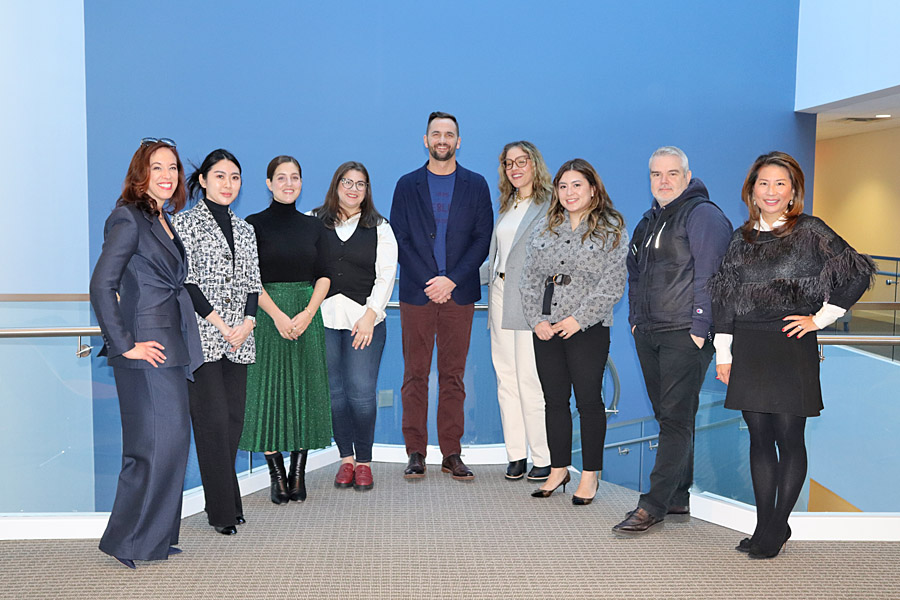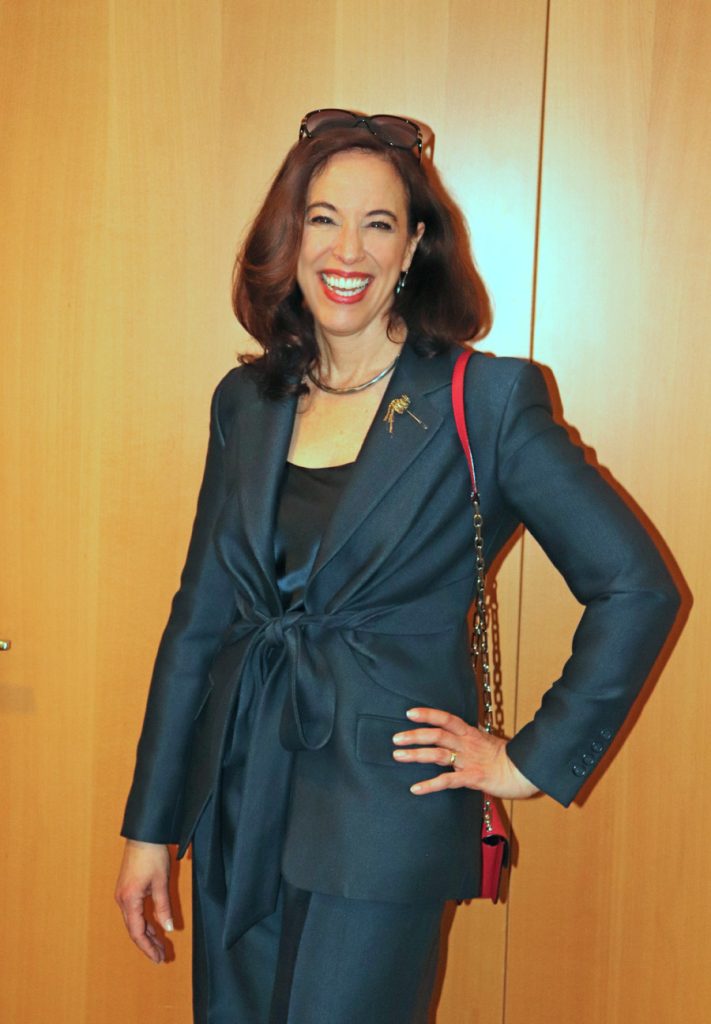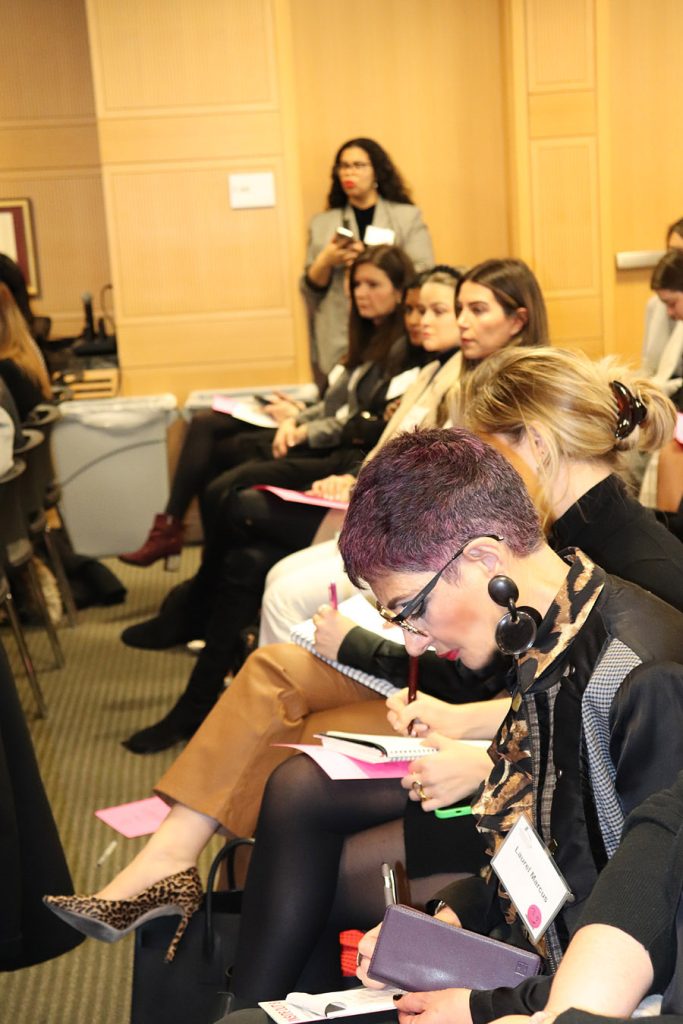
Photo Courtesy The Fashion Law Institute
Early Friday morning, The Fashion Law Institute held their 8th annual breakfast edition of Inside Out entitled “Fashion’s In-House Counsel Shared Schadenfreude.” As always, I will attempt to break it down for those who didn’t attend law school and to keep it “off the record” nothing is attributed to any particular panelist.

Photo Courtesy Fashion Law Institute
Fashion lawyers are just like you and me – they like to know what fresh hell is on a colleague’s desk rather than theirs. To that end, eight speakers (many professors at Fashion Law Institute and their day jobs at major fashion corporations) comprised the panel, with the ever-chic and perky Professor Susan Scafidi, Founder and Director of Fashion Law Institute at Fordham, serving as moderator.
Panelists were: Alice Pang: Lead Intellectual Property Counsel, Ralph Lauren; John Maltbie, Director of Civil Enforcement, Intellectual Property, Louis Vuitton; Jana Checa Chong, Senior Intellectual Property Counsel, Louis Vuitton; Lizzy Han, Senior Counsel, Chanel; Angie Byun, Principal, AB World; Ariel Sodomsky, Assistant General Counsel, Legal – Commercial, Coty; Ashley Valdes, Principal Counselor, Warby Parker; and Nick Barnhorst, General Counsel, Fresh.
The conversation was topical, including some of the most recent IP court cases plucked straight out of the New York Times – ones that you might have heard of. From Hermès winning case against Mason Rothschild’s MetaBirkins, to Jack Daniels vs. Bad Spaniels (VIP Products LLC made a dog toy out of the likeness of a bottle of Jack), to the deepest of deep fakes – when Drake and 21 Savage mocked up and promoted their cover status on Vogue going so far as to dummy up an entire distribution of free magazines as a lead-up campaign publicity stunt to introduce their album “Her Loss.”
Also, what does “Clean” mean in cosmetics? Did you know that there is no “legal” definition despite what Sephora is touting – and some say there should be more, not less governmental regulation in that arena?

In today’s culture wars, nothing is too minor – even dog toys are getting attention. Should Budweiser sue over “Buttwipers” or LV over Chewy Vuitton? The aforementioned Jack Daniels/Bad Spaniels was a poop joke gone awry (“the old No.2 on your Tennessee carpet”) – court applied Rogers v Grimaldi — a 1989 suit brought by Ginger Rogers over the film “Ginger and Fred.”
This suit stemmed from whether there could be confusion that Rogers was involved in the project that appropriated her name – a film not really about the famous dancing duo but “a pair of fictional characters who were like Rogers and Astaire only in their imagination and in the sentimental eyes of their fictional audience” according to LexisNexis. PS she lost the case – the standard is such that no one has ever won a Rogers case.

Photo Courtesy Fashion Law Journal
Questions applied to the dog toy – is it funny? Is it artistically relevant to the product? Is it willfully deceitful? As a panelist said, “we’re in a different kind of culture where maybe poop jokes aren’t so offensive anymore.” Where do you draw the line for a trademark if everything is an expression? Then there’s the “Jack Daniels affinity”– someone who likes the brand might buy the dog toy. Is Rogers the correct test for this type of case?
In the example of the NFT MetaBirkin, an artist who goes by Mason Rothschild created a digital image of a Birkin bag with some strange iterations – some with the Grinch’s fur or mammoth tusks, even one with a fetus inside (the Baby Birkin, of course) and sold them at around $500 each. Hermès quickly took action against the artist’s trading and infringement on the name Birkin.
Rothschild’s ability to commercialize these “bags” and make millions as an artistic statement did not impress the court. He was ordered to pay $133k in restitution for diluting the brand – basically a slap on the wrist, and he is appealing the decision. What if Hermès actually wanted to market their own NFT in the future? “Do we want to spend money on a digital image, or do we want the bag? I want the bag,” said Professor Scafidi echoing many sentiments in the room.
Another case mentioned involved Harry Styles suing the Northern District of Illinois for unauthorized merchandise sold on online platforms such as eBay and Etsy. In this case, not only do you not know who you’re suing, it’s like a game of Wac-A-Mole as these tricksters are impossible to find. The idea of seeking restitution is to make it unprofitable to sell these unlicensed goods.
One of the more significant fashion IP targets would be Vogue Magazine. On November 4, 2022, Drake and 21 Savage posted videos on Instagram proclaiming that they were Anna Wintour’s cover models (Jennifer Lawrence was the real cover story). This fake publicity rollout for “Her Loss” featured a professionally done complete reproduction as well as a hacking of the actual Vogue website.
Vogue filed a lawsuit in the Southern District of New York, where the court drew the line that copies handed out for free must be removed. The musicians agreed to a preliminary injunction which will probably settle the case. However, they were able to secure the #1 album spot in the country before Taylor Swift released her album and took it back. Will other artists try this stunt? Are deepfakes destined to be a wave of the future? The moral: even in this digital age, celebrities still want to be on the cover of Vogue.
Remember “morals clauses?” Believe it or not, that’s still a thing enabling Adidas to sever ties with Yeezy, aka Kanye West, aka Ye. If a brand feels it will be damaged by association, it has the right to terminate the deal, however costly. Apparently, Adidas sold $1.7 billion yearly in Yeezy products alone, while Ye earned $300-$500 million in royalties yearly. Adidas also owns the designs.
Are K-Pop stars the new “It” girls? Every designer wants them in their FROW – they are the best with morals clauses – they don’t drink, smoke, do drugs, become political, and are totally “managed,” perhaps overly so, with no say in the matter. Should this be cause for concern?
And lastly, let’s talk briefly about “clean” beauty – perhaps the hottest beauty trend. Buzzwords “clean” and “natural” have no definitive regulations. Yes, there are some chemicals, such as parabens, that many stay clear of, yet seemingly overnight, Sephora came up with a list of about 50 ingredients that are a no-no. This has caused a scramble in product development because “if you’re not clean, you’re dirty.”
Even consumers need clarification on the lack of FDA standards and have started a class action suit against Sephora for misleading advertising regarding whether the products are synthetic-free. A motion to dismiss was filed by Sephora, but it may be an uphill battle to make products free of synthetics (which are not necessarily a bad thing). Personal Care Products Council (PCPC) has asked the FDA and congress to pass more regulations –there’s a first for everything!
Latest Comments:
Iris Apfel’s 100th birthday looked like the ultimate celebration—so iconic!
The MAD About Jewelry benefit looks like a stunning event—so much talent on display!
Love the deep dive into timeless fashion trends!

Our comments section is working again…

LOVE all of this. Thank you, Marilyn. <3

My fave is the Gorski. Best look and function to me!

A Marvelous Tribute to IRIS, a one-of-a-kind work of art!

Hi Laurel,
Yes, what “fresh hell” can competing designers think of. And how clean can we call our makeup? Interesting!
Carol Troy